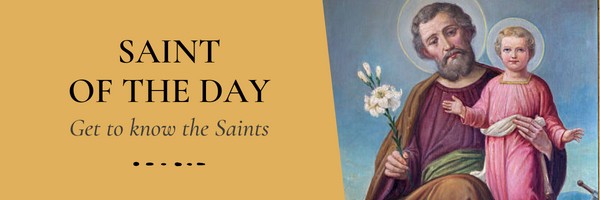
Glastonbury Abbey
FREE Catholic Classes
[G LESTINGABURH; called also Y NISWITRIN (Isle of Glass) and A VALON (Isle of Apples)]
Benedictine monastery, Somersetshire, England, pre-eminently the centre of early Christian tradition in England. Though now thirteen miles inland from the Bristol Channel, it was anciently an island encircled by broad fens, the steep conical hill called Glastonbury Tor rising therefrom to a height of about four hundred feet. Thus, difficult of access and easy of defence, it formed a natural sanctuary round which has gradually clustered a mass of tradition, legend, and fiction so inextricably mingled with real and important facts that no power can now sift the truth from the falsehood with any certainty.
TRADITIONAL ACCOUNT OF FOUNDATION
For the early history of the foundation the chief authority is William of Malmesbury in his "De antiquitate Glastoniensis Ecclesiæ" and "De Gestis Regum" (lib. I). The former work, composed apparently about 1135, was written for the express glorification of Glastonbury and consequently gives the legendary history much more fully than the latter. Malmesbury's story of the foundation and early years is briefly as follows:
In the year 63 A. D. St. Joseph of Arimathea with eleven companions was sent to Britain from Gaul by St. Philip the Apostle. The king of the period, Aviragus, gave to these twelve holy men the Island of Ynyswitrin and there, in obedience to a vision, they built a church in honour of the Blessed Virgin Mary. This church, called the vetusta ecclesia or lignea basilica, from its being constructed of osiers wattled together, was found more than one hundred years later by Fagan and Deruvian, missionaries sent to Lucius, King of the Britons, by Pope Eleutherius. Here therefore the missionaries settled, repaired the vetusta ecclesia, and, on their departure, chose twelve of their converts to remain in the island as hermits in memory of the original twelve. This community of twelve hermits is described as continuing unmodified until the coming of St. Patrick , the Apostle of the Irish, in 433, who taught the hermits to live together as cenobites, himself became their abbot, and remained at Glastonbury until his death, when his body was buried in the vetusta ecclesia . After St. Patrick his disciple, St. Benignus, became abbot at Glastonbury, while St. Daid of Menevia is also stated to have come thither, built another church, and presented a famous jewel known as the Great Sapphire of Glastonbury. The chronicler then goes on to record the death and burial of King Arthur at Glastonbury and gives a list of British saints who either died and were buried at Glastonbury, or whose bodies were translated thither on the gradual western advance of the conquering English.
The first impression produced on a modern mind by William of Malmesbury's pages is that the whole is one barefaced invention, but on this point the late Professor Freeman may be quoted as an unbiased authority (Proc. of Somerset Archæological Soc., vol. XXVI): "We need not believe that the Glastonbury legends are facts; but the existence of those legends is a great fact.… The legends of the spot go back to the days of the Apostles. We are met at the very beginning with the names of St. Phillip and St. James, of their twelve disciples, with Joseph of Arimathea at their head,… we read the tale of Fagan and Deruvian; we read of Indractus and Gildas and Patrick and David and Columb and Bridget, all dwellers in or visitors to the first spot where the Gospel had shone in Britain. No fiction, no dream could have dared to set down the names of so many worthies of the earlier races of the British Islands in the Liber Vitæ of Durham or Peterborough. Now I do not ask you to believe these legends; I do ask you to believe that there was some special cause why legends of this kind should grow, at all events why they should grow in such a shape and in such abundance, round Glastonbury alone of all the great monastic churches of Britain." And he explains the "special cause" as follows: "The simple truth then is this, that among all the greater churches of England, Glastonbury is the only one where we may be content to lay aside the name of England and fall back on the older name of Britain,… as I have often said, the talk about the ancient British Church, which is simply childish nonsense when it is talked at Canterbury or York or London, ceases to be childish nonsense when it is talked at Glastonbury." This much therefore seems certain, that when at last the West Saxons captured Glastonbury there already existed there, as at Glendalough or Clonmacnoise, a group of small churches built in typical Celtic fashion and occupied by the British monks. One of these, the oldest and most venerated of all, the vetusta ecclesia or lignea basilica, was preserved, and by its survival stamped the later buildings at Glastonbury with their special character. Indeed, its successor, falsely called the Chapel of St. Joseph, is the chief feature and loveliest fragment in the ruins that exist today.
With the coming of the English the mist clears. In the first years of the eighth century Ina, King of the West Saxons, founded the great church of the Apostles Sts. Peter and Paul, and endowed the monastery, granting certain charters which, in substance at any rate, are admitted as genuine (see Dugdale, "Monasticon Anglicanum", I). The monastery, thus firmly established, maintained a high reputation until the advance of the Danes in the ninth century, when it was ravaged and despoiled and sank into a low state. From this it was raised by the work of St. Dunstan who, as a boy, received his education in the cloister at Glastonbury, and later became abbot there, ruling the monastery, except for one brief period of banishment, until his elevation to the episcopate. (See D UNSTAN, S AINT .) There can be no doubt that St. Dunstan enforced the Rule of St. Benedict at Glastonbury as a part of his reform there, the fact being expressly recorded by his first biographer and intimate friend "the priest B.", who also tells us that in his day Irish pilgrims, learned men from whose books Dunstan himself learned much, were in the habit of coming to Glastonbury to worship at the tomb of one of their worthies, a Patrick, though doubtless not the Apostle of the Irish , which seems a clear proof of an independent Irish tradition confirming the local one mentioned above.
From St. Dunstan's date until the Normal Conquest the abbey prospered exceedingly, but in 1077 Egelnoth, the last Saxon abbot, was deposed by the Conqueror, and Thurstan, a Norman monk of Caen, installed in his place (Anglo- Saxon Chronicle, 1077). The new abbot at once began to change the local use as to the liturgy and chant for that of Fécamp. Violent disputes followed, which in 1083 ran so high that the abbot, to enforce obedience, called in armed soldiers, by whom two or three of the monks were slain and many more wounded. After this the king removed Thurstan, who was restored, however, by William Rufus and died as abbot in 1101. Under his successor Herlewin the abbey revived, but in 1184 a great fire destroyed almost the entire monastery, including the vetusta ecclesia . Rebuilding was begun at once. The beautiful stone chapel built on the site and in the shape of the lignea basilica was finished and consecrated on St. Barnabas' day, 1186, and the major ecclesia and other buildings commenced. Soon after this, however, with the consent of King Richard I , the abbey with all its revenues was annexed to the See of Bath and Wells, the bishop styling himself Bishop of Bath and Glastonbury. This meant disaster to the abbey, and an appeal was made to the pope. After much costly litigation the monks were upheld by the Holy See on every point, and the abbey's independence secured. To this incident must be assigned the long delay in completing the great church, which was not consecrated until 1303, one hundred and nineteen years after the fire. From this date until its suppression the history of the abbey is without exceptional incident. It continued to be one of the greatest pilgrim centres of England, and its connexion with the ancient British and Saxon Churches seems to have created a tendency to regard it almost as the representative of the "nationalist" aspect of the Church in England, as distinct from, and at times opposed to, the "international" forces centred at Christchurch, Canterbury. This was accentuated and embittered by a personal rivalry due to the claim of both churches to possess the body of the great St. Dunstan . No one denied that the saint had been buried at Canterbury, but the Glastonbury claim was based on a pretended transfer, alleged to have taken place in 1012; the relics, on their arrival at Glastonbury, being hidden away and not produced for public veneration until after the great fire in 1184, when a shrine was erected. That the whole story was a fabrication is clear from a letter of Eadmer, a monk of Canterbury, who declares that he had himself been present when the body was moved during the building of Lanfranc's cathedral at Canterbury in 1074, and also from the formal search and finding of the body in the Canterbury shrine in 1508 by Archbishop Warham, who then ordered the suppression of the Glastonbury shrine under pain of excommunication (Wharton, Anglia Sacra, II, 222-33).
Second only to St. Dunstan's shrine as an attraction to pilgrims was the tomb of King Arthur. The claim that Arthur was buried at Glastonbury seems to be a late one. In the "Gesta Regum" (I, xxviii) William of Malmesbury says expressly that the burial-place of Arthur was unknown. However, in his "De antiquitate Glastoniensis ecclesiæ" (Cap. De nobilibus Glastoniæ sepultis), the text of which is in a very corrupt state, a passage asserts that Arthur was buried at Glastonbury inter duas piramides . Professor Freeman rejects this as an interpolation added after Geoffrey of Monmouth's time, when the Arthurian legend had reached its final form through that writer's fabrications. There is clear evidence that the two pyramids did actually exist, and in 1191, we are told, Abbot Henry de Soliaco made a search for Arthur's body between them. Giraldus Cambrensis , who writes apparently as an eyewitness of the scene, relates (Speculum Ecclesiæ, dist. ii, cap. ix) that at a depth of seven feet a large flat stone was found, on the underside of which was fixed a leaden cross. This was removed from the stone and in rude characters facing the stone were the words Hic jacet sepultus inclitus Rex Arturius in insula Avallonia . Under this at a considerable depth was a large coffin of hollowed oak containing the bones of the king and his Queen Guinevere in separate compartments. These were later removed to a shrine in the great church. Leland (Assertio Arthuri, 43, 50, 51) records that he saw both the tomb and the leaden cross with the inscription, and Camden (Britannia, Somerset) states that the latter still existed in his day, though he does not say where it was when he saw it.
SUPPRESSION OF THE ABBEY
In 1525 Abbot Bere died, and Richard Whiting, chamberlain of the abbey, was chosen for the post by Cardinal Wolsey , in whose hands the community had agreed to place the appointment. For ten years he ruled his monastery in peace, winning golden opinions on all hands for his learning, piety, and discreet administration. Then in August, 1535, came Dr. Richard Layton, the most contemptible of all the "visitors" appointed by Thomas Cromwell, to hold a visitation in the name of King Henry VIII. He found everything in perfect order, though he covers his disappointment with impudence. "At Bruton and Glastonbury", he writes to Cromwell, "there is nothing notable; the brethren be so straight kept that they cannot offend; but fain they would if they might, as they confess, and so the fault is not with them". But the end was not far distant. The lesser monasteries had gone already, and soon it was the turn of the greater houses. By January, 1539, Glastonbury was the only religious house left standing in all Somerset, and on 19 September, in the same year, the royal commissioners arrived without previous warning. Abbot Whiting was examined, arrested, and sent up to London to the Tower for Cromwell to examine in person. Meanwhile the commissioners, regarding Glastonbury as part of the royal possessions already in view of the intended attainder of the abbot, proceeded to "dispatch with the utmost celerity" both their business as spoilers and the monks themselves. Within six weeks all was accomplished, and they handed over to the royal treasurer the riches still remaining at the abbey, which had previously been relieved of what the king chose to call its "superfluous plate", among which is specially mentioned "a superaltar garnished with silver gilt and part gold, called the Great Sapphire of Glastonbury". The words of Layton, quoted above, bear witness to the admirable condition of the monastery as regards spirituals under Abbot Whiting. As one of the indictments brought against him was that of mismanagement in temporals, it is worth while to quote Cromwell's own note in his manuscript "Remebrances" as to the booty obtained from Glastonbury at this, the second, spoliation: "The plate of Glastonbury, 11,000 ounces and over, besides golden. The furniture of the house of Glaston. In ready money from Glaston £1,100 and over. The rich copes from Glaston. The debts of Glaston [evidently due to the abbey ] £2,000 and above." While his monastery was being sacked and his community dispersed, Abbot Whiting was kept a prisoner in the Tower of London and subjected to secret examination by Cromwell. It is curious that the ordinary procedure of law, by which a bill of attainder should have been presented to and passed by Parliament, was utterly ignored in his case; indeed his execution was an accomplished fact before Parliament came together. His condemnation and execution and the appropriation of his monastery with its possessions to the Crown could only be justified legally by the abbot's attainder, but no trace that any trial did take place can be found. Such an omission, however, was not likely to trouble Cromwell, as is shown by the note in his autograph "Remembrances": "Item. The Abbot of Glaston to be tryed at Glaston and also executed there with his complycys." Accordingly Abbot Whiting was sent back to Somersetshire, still apparently in ignorance of the fact that there was now no Glastonbury Abbey for him to return to. He reached Wells on 14 November, where some sort of a mock trial seems to have taken place, and the next day, Saturday, 15 November, he with two of his monks, John Thorne and Roger James, was carried from Wells to Glastonbury. At the outskirts of the town the three martylrs were fastened to hurdles and dragged by horses up the steep sides of Tor Hill to the foot of St. Michael's tower at its summit. Here all were hanged, their bodies beheaded and cut into quarters, Abbot Whiting's head being fixed over the great gateway of his ruined abbey as a ghastly warning of the punishment prepared for such as opposed the royal will (see R ICHARD W HITING, B LESSED ). There can be no doubt that a special example was deliberately made of Glastonbury, inasmuch as by its wealth, its vast landed possessions, its munificence, and the halo of sanctity with which its past history and present observance had crowned it, it was by far the greatest spiritual and temporal representative of Catholic interests still surviving in England. The savagery with which it was attacked and ruined was intended to and did strike terror into all the West of England, and during Henry's lifetime there was no further resistance to be feared from that part of his realm. During the brief restoration of Catholicism in Queen Mary's reign, some of the surviving monks petitioned the queen to restore their abbey again, as having been the most ancient in England. The queen's death, however, put an end to all hopes of restoration.
BUILDINGS
Very little of the vast pile of buildings now remains above ground, but in its main lines the abbey followed the usual plan, a vast cruciform church on the north side, with cloister, conventual buildings, abbot's lodgings, and rooms for guests all south of this. The one unique feature was at the west end of the great church, where the west door, instead of opening to the outer air in the usual way, gave entrance to a so-called "Galilee", which in turn led into the church of St. Mary, the westernmost part of the entire edifice. This famous church, now often called in error the Chapel of St. Joseph of Arimathea , was built between 1184 and 1186 to take the place of the original vetusta ecclesia which had been entirely destroyed in the great fire of 1184. It is said to preserve exactly the size and shape of the original building and measures sixty feet by twenty- four. The Galilee was added about a century later when the western part of the great church was being completed to form a connexion between the two churches, thus making the whole western extension about one hundred and nine feet long. This western part is the most perfect of all the ruins. The Norman work of 1184, exquisite in design and very richly decorated, has stood perfectly, although in the fifteenth century a crypt was excavated beneath it to the depth of some eleven feet. At the same period tracery in the Perpendicular style was inserted in the Norman windows at the west end, portions of which still remain. Of the great church (400 feet by 80), the piers of the chancel arch, some of the chapels at the east side of the transepts, and a large portion of outer wall of the choir aisles are practically all that remains. The nave consisted of ten bays; the transepts of three each, the outer two on either side being extended eastward to form chapels. The choir at first had four bays only, but was increased to six in the later fourteenth century, the chapels behind the high altar being again modified in the fifteenth century. It is much to be regretted that so large a part of the buildings has been destroyed, but since the ruins were for long used as a kind of quarry, from which anyone might carry off materials at sixpence a cartload, the wonder is that anything at all is left. The ruins have recently been purchased at the cost of £30,000 ($150,000) through the action of the Bishop of Bath and Wells ( Anglican ) and are now held by trustees as a kind of national monument. Every effort is being made to preserve what is left, and also, by means of excavation, to recover all possible knowledge of what has been destroyed.
One curious relic still exists. The church clock, formerly in the south transept of the great church, was removed in 1539, carried to Wells, and placed in the north transept of the cathedral there. It bears the inscription Petrus Lightfoot monachus fecit hoc opus, and was constructed in the time of Abbot de Sodbury (1322-35). The outer circle of the dial has twenty-four hours on it, another within this shows the minutes, and a third again gives the phases of the moon. Above the dial is an embattled tower in which knights on horseback revolve in opposite directions every hour as the clock strikes and represent a mimic tournament. The original works were removed from Wells some years ago and may be seen, still working, in the Victoria and Albert Museum at South Kensington. This, with Lightfoot's other clock at Wimborne Minster, Dorset, are commonly held to be the oldest known. Of the conventual buildings the abbot's kitchen and a small part of the hospice alone survive. The former is an octagon set within a square and crowned with an octagonal pyramid. Within it is square in plan, the roof rising in the centre to the height of seventy-two feet. The upper part forms a double lantern of stone, which was formerly fitted with movable wooden shutters so that the smoke might always be let out on the side away from the wind. Practically all the rest is level with the ground, but mention must be made of the library, of which Leland, who saw it in Abbot Whiting's time, declares that no sooner was he over the threshold but he was struck with astonishment at the sight of so many remains of antiquity; in truth he believed it had scarce an equal in all Britain. In the town, amongst other buildings erected by various abbots, are the court-house, the churches of St. Benignus and St. John the Baptist, the tithe barn, a fourteenth-century building and the finest existing specimen of this class of structure, also the Pilgrim's Inn, a late Perpendicular work built at the end of the fifteenth century, where, it is said, all visitors used to be treated as guests and entertained for two days at the abbot's expense.
Still in the neighbourhood, in many places, one sees the ruined abbey's coat of arms : Vert, a cross botonée argent ; in the first quarter the Blessed Mother of God standing, on her right arm the Infant Saviour, a sceptre in her left hand.
THE GLASTONBURY THORN
The Glastonbury Thorn ( Crategus Oxyacantha Præcox ) is a variety of hawthorn, originally found only at Glastonbury, which has the peculiarity of flowering twice in the year, first about Christmas time and again in May. By a curious irony of fate the first mention of the Holy Thorn flowering at Christmas-tide is contained in a letter written by Dr. Layton to Thomas Cromwell from Bristol, dated 24 August, 1535. "By this bringer, my servant", he writes, "I send you Relicks : First, two flowers wraped in white and black sarsnet, that on Christen Mass Even, hora ipsa qua Christus natus fuerat, will spring and burgen and bare blossoms. Quod expertum est saith the Prior of Mayden Bradley." In a life of St. Joseph of Arimathea, printed in 1520 by Richard Pyerson, a pupil of Caxton, there is, however, an earlier notice of its coming into leaf at Christmas :
The Hawthornes also, that groweth in Werall [Wearyall Hill]Do burge and bere grene leaves at Christmas
As freshe as other yn May…
Later references to the fact abound, e.g. Sir Charles Sedley's verse:
Cornelia's charms inspire my lays,Who, fair in nature's scorn,
Blooms in the winter of her days,
Like Glastonbury Thorn
and the lines in Tennyson's "Holy Grail":
…Glastonbury, where the winter thornBlossoms at Christmas, mindful ofOur Lord.
The original thorn tree on Wearyall Hill was cut down in 1653 by some fanatical soldier of Cromwell's army, to the great annoyance of Bishop Goodman of Gloucester who wrote to the Lord Protector complaining of the outrage; but before that date slips had been taken from it, and many specimens now exist which blossom about Christmas time. The blossoms of the Christmas shoots are usually much smaller than the May ones and do not produce any haws. It is noteworthy also that plants grown from the haws do not retain the characteristics of the parent stem, and the Glastonbury gardeners propagate the thorn by budding and grafting only. Botanists are not yet agreed as to the origin of the Glastonbury thorn. Some have desired to identify it with the Morocco thorn, introduced into England about 1812, which puts forth its leaves very early in the year, sometimes even in January; while others claim it as the Siberian thorn, which begins to produce its shoots in January. Neither of these varieties, however, has the special peculiarity of the Glastonbury thorn, that of flowering twice. Possibly the truth may be that the Glastonbury thorn was originally an individual or "sport", and not a true variety; but if this is so it is certainly remarkable that for four hundred years the peculiarity of the tree has been preserved and transmitted to its progeny. The legend that the original tree grew from the staff of St. Joseph of Arimathea, which was thrust into the ground and took root, is found before the destruction of the abbey, but the date of its origin cannot now be ascertained.
Join the Movement
When you sign up below, you don't just join an email list - you're joining an entire movement for Free world class Catholic education.
An Urgent Message from Sister Sara – Please Watch
- Advent / Christmas
- 7 Morning Prayers
- Mysteries of the Rosary
- Litany of the Bl. Virgin Mary
- Popular Saints
- Popular Prayers
- Female Saints
- Saint Feast Days by Month
- Stations of the Cross
- St. Francis of Assisi
- St. Michael the Archangel
- The Apostles' Creed
- Unfailing Prayer to St. Anthony
- Pray the Rosary
![]()
Copyright 2025 Catholic Online. All materials contained on this site, whether written, audible or visual are the exclusive property of Catholic Online and are protected under U.S. and International copyright laws, © Copyright 2025 Catholic Online. Any unauthorized use, without prior written consent of Catholic Online is strictly forbidden and prohibited.
Catholic Online is a Project of Your Catholic Voice Foundation, a Not-for-Profit Corporation. Your Catholic Voice Foundation has been granted a recognition of tax exemption under Section 501(c)(3) of the Internal Revenue Code. Federal Tax Identification Number: 81-0596847. Your gift is tax-deductible as allowed by law.












